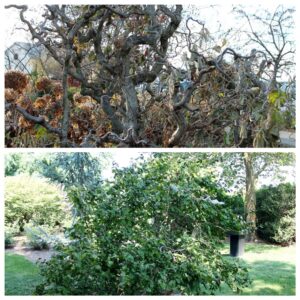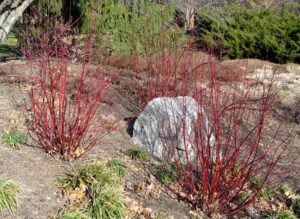Better Naked
February 21st, 2023
Traipsing through the winter landscape one day, it occurred to me that some plants are actually better looking with their leaves off.

I like the twisty bare branches of Harry Lauder’s walking stick in winter, top. The plant looks ordinary and even gangly to me in summer, below.
Whether it’s bright color on the stems or just interesting branching habits that are much more visible in winter, some plants are at their best naked.
The poster child of that is the shrub known as Harry Lauder’s walking stick (Corylus avellana ‘Contorta’). This is a shrubby version of filbert grown mainly for its twisty, contorted branch structure.
However, summer leaves hide or at least downplay that interest. When Japanese beetles show up to eat Harry’s leaves in July and when heat or all-too-common fungal disease attack, the plants look horrid.
But when the plant finally has the good sense to shed its ratty leaves in fall, its nakedness unveils the plant’s hidden curiosity. You almost wish Harry would croak to keep it leafless for good.
Another beauty unveiled in winter is the red-twig dogwood (Cornus sericea) and its sister, the yellow-twig dogwood.
These are different than the white- and pink-blooming trees most people know as dogwoods.
Red-twigs and yellow-twigs are multi-stemmed shrubs that grow about six feet tall and wide. They don’t do anything terribly exciting in the growing season, other than make a few half-hearted attempts at white flower clusters followed by small white fruits.

These shrub dogwoods are more colorful in winter than in summer.
The variegated types are also particularly prone to fungal leaf-spot disease, which looks like the plants have come down with a bad case of measles by mid-summer.
When the leaves drop, though, the bare upright stems of bright red and golden yellow literally glow in the late-afternoon autumn sun. They turn even redder or yellower as temperatures drop, and they’re particularly stunning when fresh snow drops around their ankles.
Cut both of these shrub dogwoods nearly to the ground at the end of each winter to encourage all new stems, which color best in their first winter.
A third winter stunner is the coralbark maple (Acer palmatum ‘Sango Kaku’), a 20-footish small tree with pointed leaves of light green.
It’s good-looking all season, but the highlight is when dropped leaves expose the neon-coral trunk and branches.
‘Sango Kaku’ can be a little picky, so give it good drainage, a dose of compost at planting time, a good soaking during hot, dry spells, and a wind-protected site, ideally out of direct afternoon sun.

These Japanese maples at Hershey Gardens look pretty good to me, even through they’re bare.
One other plant I should mention is Japanese maple. I actually like the form and branch structure of the weeping types even better in winter than during the growing season. But unlike Harry and the shrub dogwoods, Japanese maples can be stunning in other seasons, too, especially when their foliage turns red in fall.
The same is true for most trees that have interesting bark. It’s not that the trees don’t look good at other times, it’s just that we tend to notice their attractive bark more in winter when flowers, fruits, and fall foliage aren’t around to distract us.
Some of my favorites in this camp are river birch, (Betula nigra), paperbark maple (Acer griseum), dawn redwood (Metasequoia glyptostroboides), the Korean and Japanese stewartias (Stewartia koreana and pseudocamellia), Persian ironwood (Parrotia persica), and Kousa dogwood (Cornus kousa).
Ninebark (Physocarpus opulifolius) and oakleaf hydrangea (Hydrangea quercifolia) are two of my favorite naked shrubs in winter.
If you’re light on this aspect of your winter landscape, think about going naked at planting time this year.
A good place to put these winter charmers is dead-center out favorite windows. There you can enjoy them over winter without going outside.







